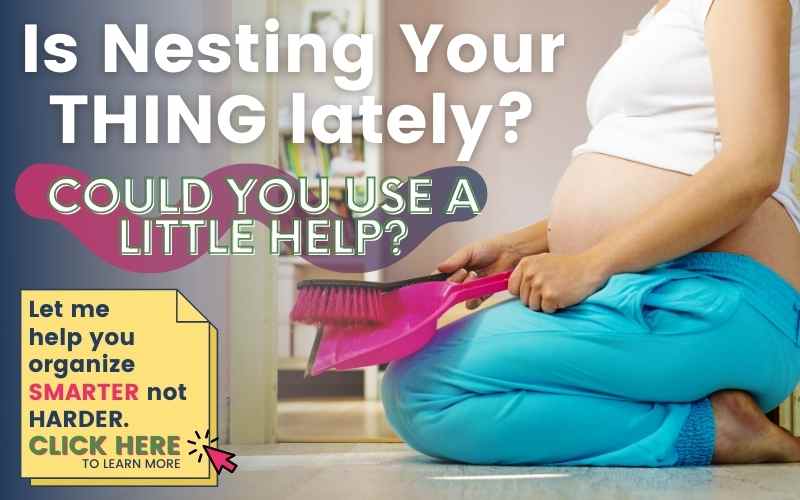Am I in labor quiz? Pregnant women ask themselves that so many times — all the contractions, plus what are you looking for to know you’re IN labor? This post includes an “Am I in labor checklist” as well as an “am I in labor quiz” — it will help you recognize the signs & symptoms of labor.

Let me be the first to say, that even with being a nurse since 1997 and having 20 years of labor and delivery experience, labor is still confusing. Knowing you’re in labor is SUPER confusing — so I am hoping to clear some of that up for you today!
As you can tell — this article has a LOT of things to offer!
Table of contents
- Am I in labor? Checklist
- Am I in Labor Quiz
- What is the first sign of labor?
- How do you tell if you’re having contractions
- When should you go to the hospital?
- What is False Labor
- What are some Signs that Labor is Approaching
- What Do Early Labor Contractions Feel Like
- How to Go into Labor
- Are you afraid of delivery?
Am I in labor? Checklist
We’re going to go through all the things to look for, but if you love you some checklists, check out this. In just a few minutes you can really understand labor — rather than just thinking checks in boxes (but we have those too).
When I envisioned labor it was always the stuff that was in the movies. Boom, your water breaks and then about 3 seconds later the baby is flying out. {movie magic}, a baby has appeared!. Congrats! In reality, it’s hard to know exactly what’s a contraction and what’s just one of the usual aches and pains of pregnancy.
Your uterus is a giant muscle and it is attached to parts of you. It stretches and aches. That doesn’t mean the baby is coming. It just means that parts of pregnancy can be pretty miserable.
Am I in Labor Quiz
This one is going to quickly take you through some of the things to watch for.
I’d encourage you to then finish reading this post to find out more about each option….
There are just about 100 points possible — so, just like regular labor, there is a pretty large scale.
I also have a little crystal ball quiz that asks WHEN will I go into labor. And btw, if I could figure that out, I’d be much richer than I am now. No one knows but mother nature. 🙂
Want to know a few more things about labor? These might help:
- Guaranteed Ways to Induce Labor
- 3 Things to Do At the End of Your Pregnancy for a Faster Labor
- The Cascade of Interventions: The domino effect in labor
- What To Do If Your Labor Goes Long?
- 40 weeks + a day and No Sign of Labor?
Signs of Labor FAQ’s:
What is the first sign of labor?
Normally, the early signs of labor are lower back pain and cramping feelings — like you had when you were getting your period, and then it progresses from there. That would be considered the early stages of labor. Or, it could be regular pregnancy pains (and it can be hard to tell the difference).
It’s important to note that labor is a LOT of different signs & symptoms. Contractions are just one of them!
How do you tell if you’re having contractions
Your uterus will tighten. I find that it’s best to tell if your belly is tightening when you’re laying down (as when you stand-up your abdominal muscles might be tight). I have a whole post that tells what a contraction feels like.
Most often, the pains go from irregular contractions to more regular ones. It is a good idea to time them when they seem closer together than 10 minutes or so (so, more than 12-15 in an hour).
Contractions may start off as just “tightening” (which you may or may not notice), then cramping, and then progress into painful contractions.

What week does labor usually start?
Well, 40 weeks of pregnancy is the average (many people go more than 40 weeks). You really don’t want to go into preterm labor…
Remember all of that is an AVERAGE. You can check out my pregnancy calendar to learn your important pregnancy dates.
Even if you’re in your third trimester — baby is still not “ready” — better for baby to come after 37 weeks. Prior to 36-37 weeks, that would be considered a preterm birth.
Premature babies (born before 36 weeks) often have to spend some time in the neonatal intensive care unit, with some support as they grow and feed until they can safely live in the outside world.
Are you thinking, gosh — there’s a lot to know about labor that my provider hasn’t covered? I’ve got you!
The thing is, providers think most people are taking a birth class (because most smart people do) — but Tuesday nights at 6 pm just doesn’t work for most couples anymore. I recommend The Online Prenatal Class for Couples — it is….
- Available 24/7
- Created for couples to do together
- Your all-in-one stop for all things birth prep (including breastfeeding in the bundle).
What triggers labor?
Basically, the baby and your uterus deciding it’s done. It’s a complex mechanism of hormones, and more than I want to get into here.
We talk a bit about how to go into labor in this podcast episode on ways to go into labor with my friend and fellow RN Mandy. And I have a guide that talks about how your body decides to go into labor.
When should you go to the hospital?
I talk a LOT about that in my prenatal class, but I’d also ask your doctor what he/she thinks. There are a few reasons (besides labor) to call your doctor or the hospital.
The best thing is to listen to your doctor and your mommy gut about going to the hospital.
Does nesting mean labor is near?
I mean, if — by “near” you mean in the next few months. Then, yes. Nesting isn’t a sign of labor though.
BTW, if you’re wanting to nest a bit more I love this course on home organization.
How can I avoid pooping in labor?
I have a whole post on avoiding pooping when you’re in labor — there are a FEW things (but not all of it is under your control).
Is tightening of the stomach a sign of labor?
Tightening of the UTERUS is a sign — because that is a contraction. I find it’s easier to tell that when you lay down.
However, your body will have Braxton Hicks contractions (sometimes known as false labor or practice contractions) now and then as your uterus is irritable or just a random contraction now and then — and that does NOT mean you’re going into labor.
Real contractions will continue to get closer together or more painful (and then progress into labor). False labor does not, it’s really that simple (but doesn’t SEEM that simple when it’s happening to you).
I do have a post on what to do if your belly feels hard.
What is False Labor
The horrible news is that false labor feels JUST like true labor contractions. Also, false labor can TURN into true labor. I have this awesome full post about false labor pains. How you can tell the difference between a false alarm, or, real labor contractions?
You should ask your healthcare team how many contractions/are OK if you’re before 36 weeks.
If you have questions about true vs false labor I really recommend joining The Online Prenatal Class for Couples. We go over the stages of labor and what to expect from your body (as well as when to consider going to the hospital. PLUS ways to talk with your provider to get your questions answered best.
Is my amniotic sac broken?
One of the TRUE signs of labor is your water breaking. Of course, that can be tricky to know too! (Seriously, can’t SOME of this be easy?)
I know all too well the feeling of wondering if you either wet your pants, if it’s just a lot of vaginal discharge (or pee), or actually amniotic fluid.
How do I know if I’m going into preterm labor?
The symptoms of preterm labor and “regular” labor are basically the same — Cramping, back pain, and feeling your uterus tighten.
The only difference is that you want to catch them early (vs it’s best to ignore them a while if you’re past 37 weeks as they may come and go). If you think you’re in preterm labor, you should call your provider and if you’re unable to get hold of them, you’ll want to head into labor and delivery to prevent premature birth (there may be medications they can give you to stop contractions).
What are some Signs that Labor is Approaching
Labor has some tell-tale signs that tend to appear somewhat together. If you see a few of these labor signs all at once, you might start to think it IS the real deal. Signs you’re going into labor include diarrhea, loss of mucus plug and more SUPER fun things. You’ll be sure to want to click to that post right? Labor isn’t always pretty, but I bet you’ll find that post SUPER helpful!
What are the Symptoms of Labor?
Signs of preterm labor can be the same as regular labor including:
- Cramping
- Back Pain
- Stomach upset/nausea
- Generalized Malaise
- Loss of mucus plug
- Changes in discharge/leaking amniotic fluid
What about Losing Your Mucus Plug/Brownish Discharge
A lot of people feel like losing your mucus plug means you’re going into labor. They’re wrong. 🙂
Cliff notes: Your mucus plug is just sitting your cervix protecting the baby the first couple of trimesters and then it will fall out. It isn’t much of a sign of anything on it’s own, it doesn’t even mean you’ve really dilated much.
If you see vaginal bleeding (especially bright red), you may want to call your provider. Although bloody show can be normal during labor it’s good to stay in touch with them.
Pack Your Hospital Bags before going into labor
If you THINK you’re in labor — it’s a great time to pack your hospital bag. I have seen a lot of 3 piece luggage sets come into the labor room. I mostly feel bad that she’ll have to put all those useless items away once she gets home.
A small bag should do it. While we’re at it — I have a whole hospital checklist of ALL the things you should do before the baby comes!
Cliff notes version for the three most important things to put in your hospital bag:
How to Go into Labor
You might be reading this page wanting to know HOW to get that baby out! This post will show you how to go into labor. I should say that I think it is a good idea to wait until your full due date, and there are a lot of perks to being overdue with your baby (I am well aware that one of the perks is NOT being comfortable — but it is worth it!) The less you do to prod that baby out, the better the outcome is likely to be!
I even have a podcast with my friend Mandy on it:
I also have a handy guide on my best tips to going into labor:
Now, if there is an issue with health problems (for you or the baby) your health care provider may choose to do an earlier induction (this is my post on 37 week inductions). These can be things like high blood pressure, or diabetes.
Are you afraid of delivery?
The one thing EVERY family brings into the labor room is a little (or a lot) of anxiety. Such a big day. So many pieces that need to fall into place. So many unknowns. I can tell you that your labor nurse is your life preserver. She wants to explain things and help you on this special journey. I have a whole post dedicated to JUST pregnancy fears. There’s a lot to take into your heart and hopefully, this puts your mind at ease a bit.
Truth Bomb: The best way to fight fear is facts and knowledge, I find….
What can you do to stay safe during pregnancy?
As you head into the final stretch be SURE you’re doing your kick counts — checking for decreased fetal movement! It’s the best way you can know your baby is thriving inside of you! I also have a whole post on if baby is moving more, does it mean you’re going into labor?
Also, continue to eat a healthy diet. Eat across the rainbow and balance carbohydrates with proteins to feel your best. And don’t forget to stay hydrated!
Of course, labor isn’t the only reason you’d want to call your doctor’s office. There are many other reasons you’d want to call your doctor. And yes, we talk ALL about how to call your doctor (or get in touch with someone) after office hours — because that part can be very stressful.
Of course, going into labor isn’t the only thing you’ll have on your mind….
It’s really time to get prepared for the whole thing and so many parents have regrets they didn’t understand more before going to the hospital.
It is not too late to take a prenatal class. You can join me in The Online Prenatal Class for Couples — where, in just 3 hours we’re going to help you feel SO much more confident about your birth. We really teach from bump to bassinet — and I guarantee you’ll feel more prepared.
Or, if you JUST want to understand the signs of labor (or your budget is real tight) join me in my Labor Made Easy class — it’s a quick way to easily get all this information with your partner.
Or, if all of that is too much, check out my free prenatal class — It’s your first step towards being your own birth boss.







